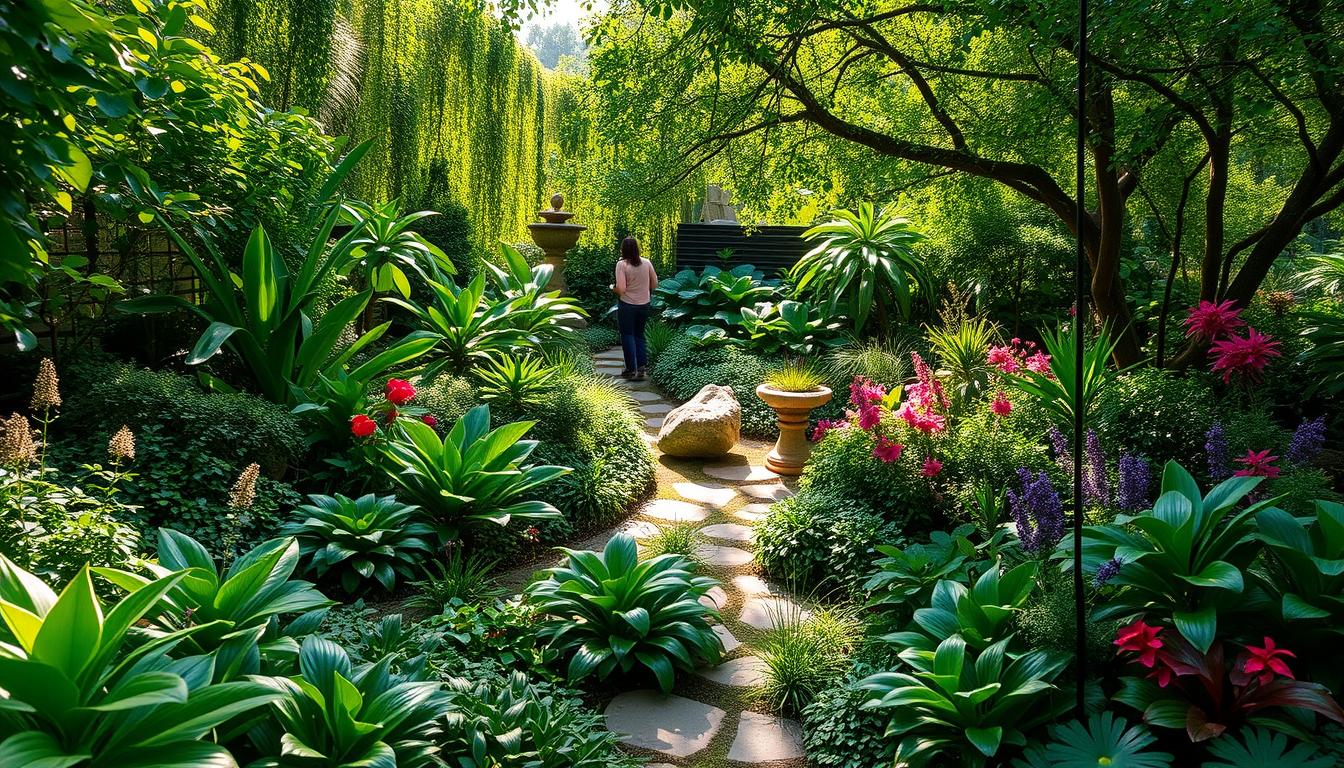Your outdoor space has the potential to become a stunning retreat with the right approach. Whether you have a small patch or a sprawling area, strategic planning can make all the difference. This guide explores 11 diverse styles that cater to various needs and preferences, from modern minimalist layouts to practical edible landscapes.
Every space is unique, and so are the solutions. If you’re dealing with limited room or challenging climates, there’s a style for you. We’ll also touch on USDA hardiness zones and regional considerations to ensure your efforts thrive year-round.
For those who love a hands-on approach, we’ve included expert-approved plans to help you get started. These designs not only enhance your property’s value but also create a space for relaxation and enjoyment. Plus, we’ll share seasonal maintenance tips to keep your yard looking its best.
Looking ahead, we’ve incorporated trending styles for 2025, making this the ultimate resource for American homeowners. Ready to transform your outdoor area? Let’s dive in!
Key Takeaways
- Discover 11 unique styles to suit any space or climate.
- Learn about USDA hardiness zones for regional success.
- Access downloadable plans from expert sources.
- Enhance property value and outdoor enjoyment.
- Stay ahead with trending 2025 styles.
- Get seasonal tips for year-round maintenance.
Introduction: Elevate Your Outdoor Living with Garden Plant Design Ideas
Transform your yard into a functional and beautiful retreat with thoughtful planning. According to the 2023 NAHB report, 68% of homeowners prioritize enhancing their outdoor living areas. Whether you’re looking to boost property value or create a personal oasis, the right approach can make all the difference.
Take inspiration from a California family who increased their home’s value by 12% through a drought-tolerant redesign. As Mavis Torke, a renowned illustrator, puts it:
“Gardens should reflect personal style while solving practical needs.”

To help you get started, we’re offering downloadable plans, including a Russian sage and catmint layout. For even more options, the Almanac Garden Planner provides over 800 layouts tailored to your needs. Don’t forget to check the USDA Plant Hardiness Zone Map to ensure your choices thrive in your region.
Key design elements like color theory, vertical gardening, and companion planting can elevate your space. Looking ahead, 2025 trends such as night gardens, smart irrigation, and habitat corridors are set to redefine outdoor living.
Success stories abound, like an urban balcony garden that produces 40lbs of vegetables annually. This article is your comprehensive guide to creating a space that’s both beautiful and functional, no matter the size or location of your yard.
1. Modern Minimalist Garden Design
Simplicity meets sophistication in a minimalist outdoor setup. This style focuses on clean lines, uncluttered spaces, and a calming aesthetic. It’s perfect for those who appreciate a sleek, organized look.
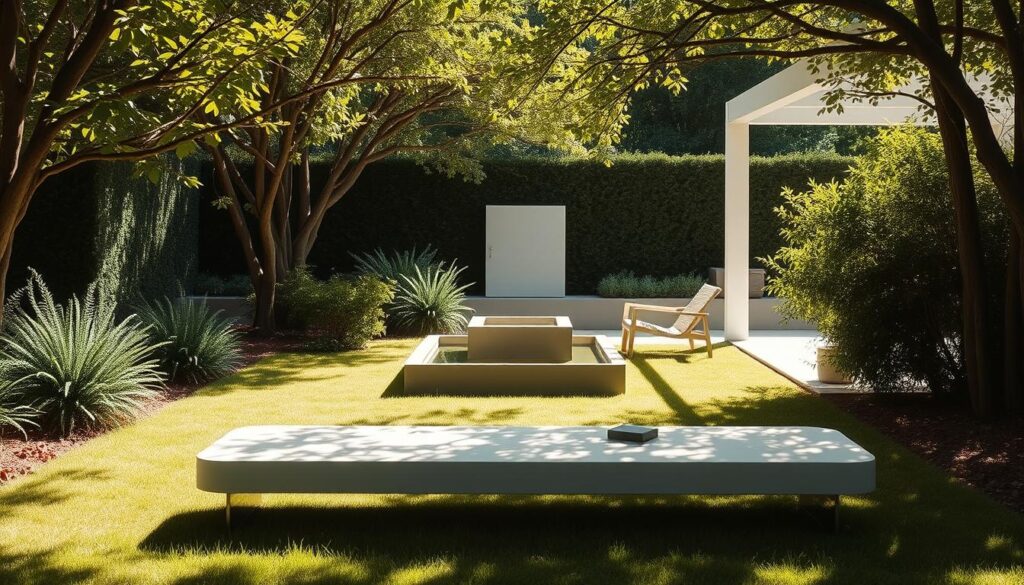
Choosing the Right Plants for a Clean Look
Selecting the right elements is key to achieving a clean look. Opt for plants like Russian sage, lavender, or Dwarf Korean lilac. These choices add texture without overwhelming the space.
Feather Reed Grass and Blue Star juniper are excellent for adding subtle movement and structure. Stick to a monochromatic palette with shades of green and silver for a cohesive feel.
Incorporating Hardscaping Elements
Hardscaping plays a crucial role in modern minimalism. Use materials like laser-cut steel edging and polished concrete planters. These elements add a contemporary touch while maintaining functionality.
For a budget-friendly option, consider stenciling concrete to mimic high-end materials. Avoid invasive species like running bamboo, which can disrupt the clean lines of your setup.
Case studies, like an Arizona courtyard using decomposed granite and ocotillo sculptures, showcase how hardscaping can transform a space. Pair these features with recessed LED lighting for a polished finish.
2. Traditional Cottage Garden Charm
Embrace the timeless appeal of a traditional cottage-style retreat. This style combines classic charm with a relaxed, inviting atmosphere. It’s perfect for those who love a mix of vibrant flowers and natural textures.
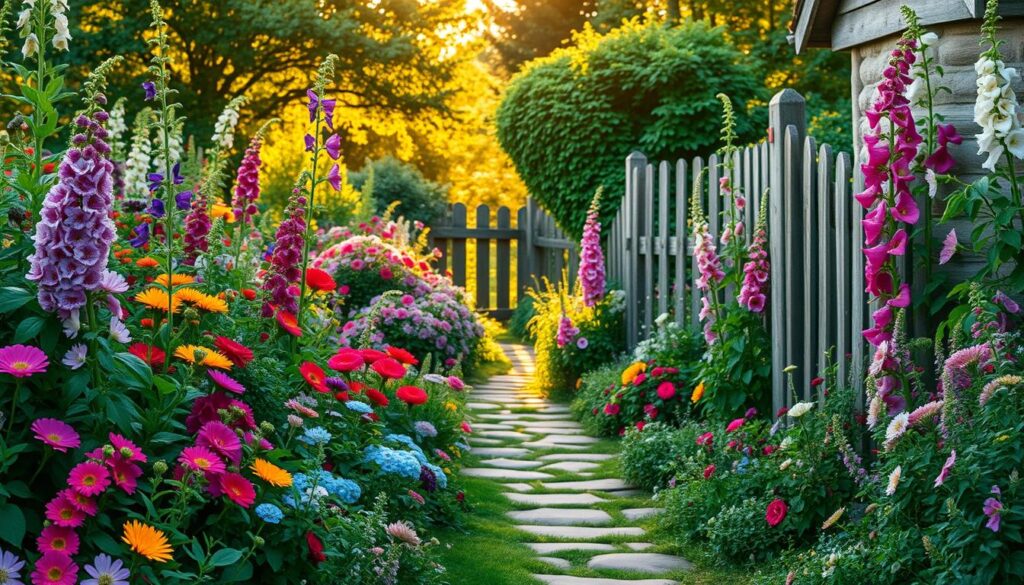
Selecting Classic Cottage Plants
Choosing the right cottage plants is essential for achieving an authentic look. Must-have options include David Austin roses, foxgloves, and hollyhocks. These flowers add height, color, and structure to your space.
For a dynamic display, consider succession planting. Start with spring bulbs, followed by peonies, phlox, and asters. This ensures year-round interest and keeps your gardens vibrant.
Creating a Cozy, Informal Layout
An informal layout is key to capturing the cottage aesthetic. Use materials like crushed oyster shells or reclaimed brick for pathways. These choices add character and blend seamlessly with the natural surroundings.
Incorporate vertical elements such as rustic obelisks with clematis ‘Nelly Moser.’ These features not only add height but also create a sense of whimsy. Plus, they attract pollinators, boosting biodiversity by 23% compared to formal setups.
| Plant | Feature | Maintenance Tip |
|---|---|---|
| David Austin Roses | Fragrant blooms | Prune in early spring |
| Foxgloves | Tall, striking flowers | Deadhead regularly |
| Hollyhocks | Vertical growth | Stake for support |
For a cohesive yet chaotic look, limit your color palette to five hues. Follow Gertrude Jekyll’s principles of color borders to create a harmonious blend. Add sweet alyssum along walkways for a fragrant touch.
Finally, use flowering groundcover like thyme or sedum as living mulch. This reduces maintenance while keeping your space lush and vibrant. With these tips, you’ll create a charming retreat that’s both beautiful and functional.
3. Low-Maintenance Perennial Gardens
Creating a low-maintenance outdoor area doesn’t mean sacrificing beauty or variety. With the right perennials, you can enjoy a vibrant space that requires minimal effort. These hardy plants return year after year, making them a smart choice for busy homeowners.
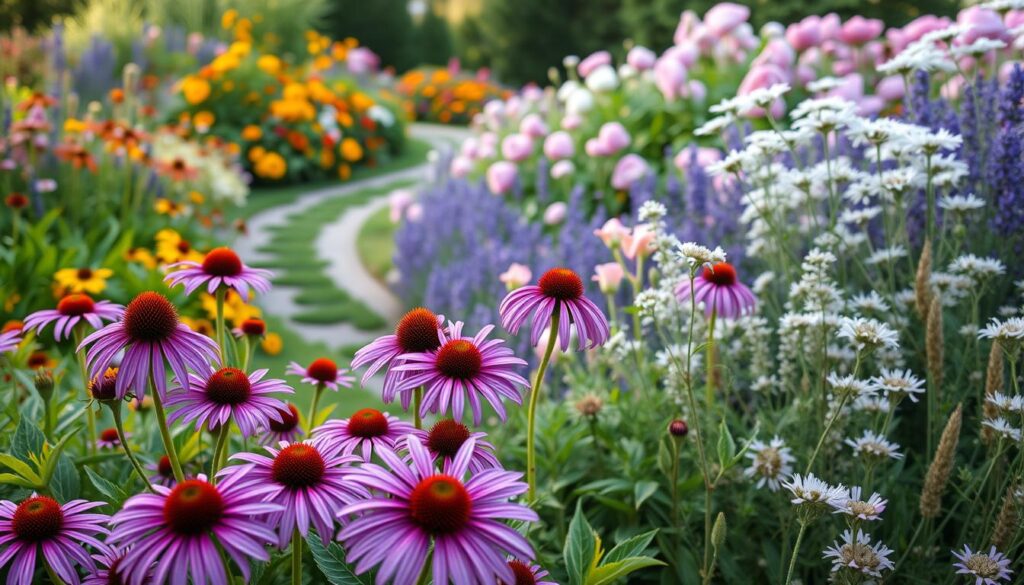
Best Perennials for Easy Care
Choosing the right perennials is key to achieving easy care. Top performers include ‘Autumn Joy’ sedum, Russian sage, and daylilies. These plants thrive in various conditions and require little attention once established.
For added texture and movement, consider ornamental grasses like blue fescue. Pair them with lamb’s ear for a striking contrast. This combination not only looks great but also reduces maintenance needs.
Design Tips for Year-Round Appeal
To ensure year-round appeal, follow a simple formula: 30% evergreens, 50% bloomers, and 20% ornamental grasses. This balance keeps your space lively in every season.
For winter interest, add plants like coral bark maple or red twig dogwood. Their vibrant colors and textures stand out against the snow. Seed heads from plants like coneflowers also add visual interest.
| Plant | Feature | Care Tip |
|---|---|---|
| ‘Autumn Joy’ Sedum | Late-season blooms | Prune in early spring |
| Russian Sage | Drought-tolerant | Cut back in late winter |
| Daylilies | Long blooming period | Divide every 3-4 years |
Prepare your soil with a 3″ compost layer to reduce fertilization needs. Use soaker hoses under 2″ hardwood mulch for efficient watering. Interplant with alliums to naturally deter pests.
For a budget-friendly approach, divide hostas every three years. This not only saves money but also keeps your space fresh and vibrant. Visit NewGen Living for more tips on creating a low-maintenance outdoor area.
4. Raised Bed Vegetable Gardens
Raised beds offer a practical and efficient way to grow fresh produce in your outdoor space. They provide better drainage, improved soil quality, and easier access for planting and harvesting. Whether you’re a beginner or an experienced grower, raised beds can transform your vegetable garden.

Benefits of Raised Beds for Vegetables
One of the biggest advantages of raised beds is their ability to maximize yield. According to a UMass study, raised beds produce 1.5lbs/sq ft compared to 0.8lbs in-ground. They also reduce the risk of soil compaction and allow for better root growth.
Materials like cedar and composite lumber are popular choices. Cedar is durable and naturally resistant to rot, while composite lumber offers a longer lifespan. Both options ensure your raised bed lasts for years.
Planning Your Vegetable Garden Layout
Start with a soil mix of 60% topsoil, 30% compost, and 10% perlite. This combination provides the nutrients and drainage your plants need. For a structured approach, consider a 4-bed system for crop rotation to prevent diseases.
Companion planting is another smart strategy. Pair tomatoes with basil and marigolds to deter pests naturally. Use a grid-based drip irrigation system with a smart timer for efficient watering.
To protect against pests like voles, install hardware cloth under the beds. For vertical growth, add cattle panel arches for cucumbers or beans. Succession planting, such as spring peas followed by summer beans and fall kale, ensures a continuous harvest.
5. Colorful Flower Beds for Every Season
Brighten your outdoor area with vibrant blooms that thrive in every season. By carefully selecting flowers and applying color theory, you can create a stunning display that evolves throughout the year. This approach ensures your space remains lively and inviting, no matter the time of year.
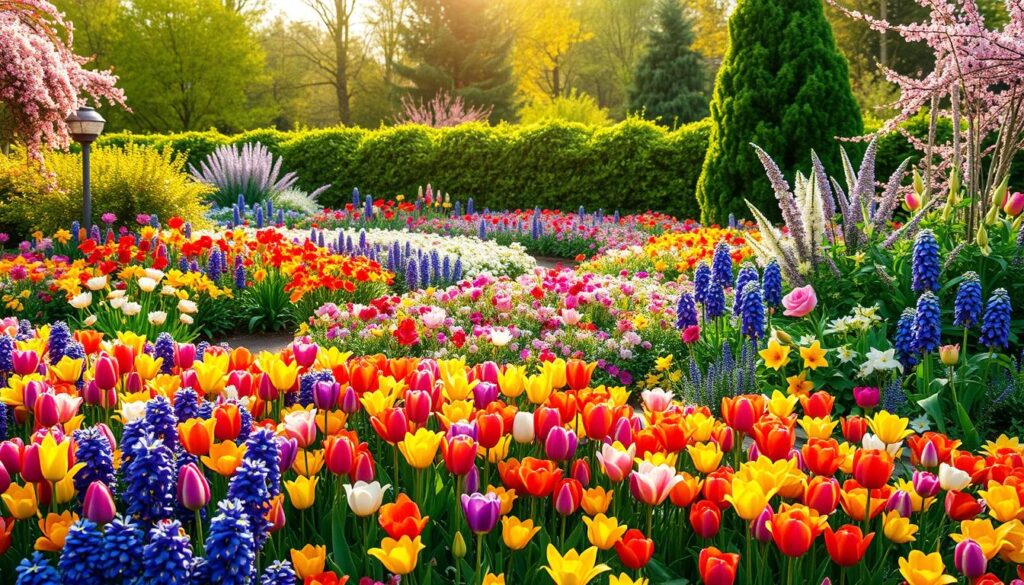
Selecting Flowers for Continuous Bloom
To achieve continuous bloom, plan a sequence of flowers that take turns shining. Start with crocus and tulips in spring, followed by iris and roses in summer, and finish with chrysanthemums in fall. This staggered approach keeps your beds vibrant year-round.
Incorporate foliage stars like Heuchera ‘Midnight Rose’ and Japanese painted fern for texture and color. These plants add depth even when blooms are sparse. For hot weather, consider lantana and portulaca, which thrive in summer heat.
Designing with Color Theory in Mind
Using color theory can elevate your flower beds. Choose a monochromatic scheme, like an all-white display, for a serene look. Alternatively, try complementary colors like purple and yellow for a bold, eye-catching effect.
Repeat three key colors throughout your beds for a cohesive design. Use the thriller-filler-spiller formula: tall plants like snapdragons as thrillers, mid-height flowers like zinnias as fillers, and trailing plants like sweet alyssum as spillers.
| Flower | Season | Color |
|---|---|---|
| Crocus | Spring | Purple, White |
| Tulips | Spring | Red, Yellow |
| Iris | Summer | Blue, Purple |
| Roses | Summer | Pink, Red |
| Chrysanthemums | Fall | Yellow, Orange |
For pollinator-friendly options, include UV-reflective blooms like borage. These attract bees and butterflies, enhancing biodiversity. Regularly deadhead spent flowers to encourage new growth and maintain maximum blooms.
By following these tips, you can create a dynamic and colorful outdoor space that delights in every season.
6. Drought-Tolerant Garden Designs
Adapting to dry climates doesn’t mean compromising on beauty or functionality. With the right approach, you can create a sustainable and visually appealing space that thrives with minimal water. This section explores the best plants and techniques for a drought-tolerant setup.
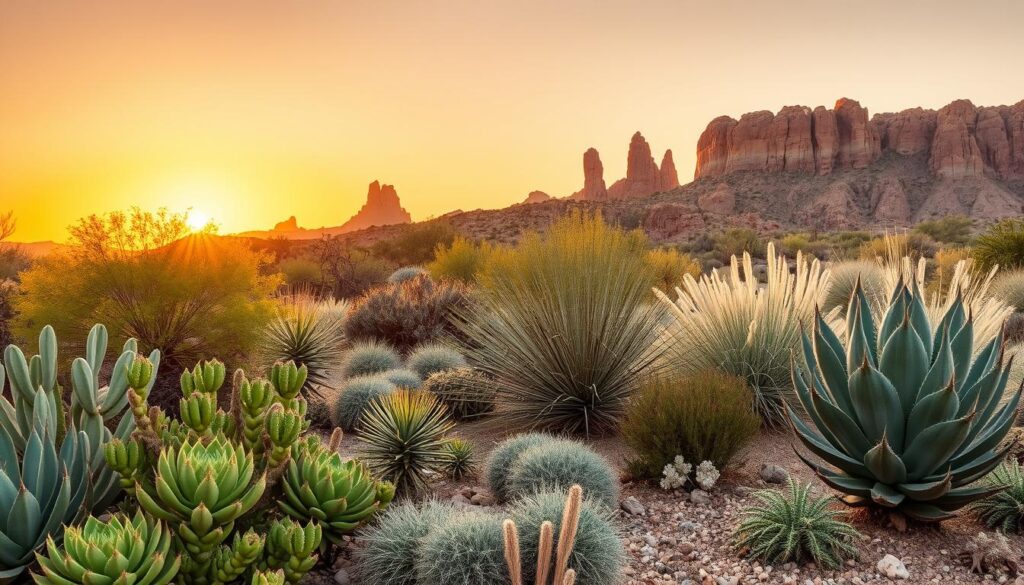
Best Plants for Dry Climates
Choosing the right plants is essential for success in arid conditions. Top performers include Agastache ‘Blue Fortune’ and Sedum ‘Dragon’s Blood.’ These low-water perennials are hardy, vibrant, and require little maintenance once established.
Group plants by their water needs into zones: oasis, transition, and arid. This strategy ensures efficient water use and healthier growth. For example, Russian sage and catmint thrive in arid zones, while lavender prefers transition areas.
Water-Saving Design Techniques
Smart design can significantly reduce water consumption. Start with soil preparation by adding a 4″ gravel layer under planting pockets. This improves drainage and reduces evaporation.
Consider a subsurface bladder irrigation system with moisture sensors. This method delivers water directly to the roots, minimizing waste. Pair it with permeable pavers and thyme-filled joints for a water-saving hardscape solution.
| Plant | Water Zone | Feature |
|---|---|---|
| Agastache ‘Blue Fortune’ | Arid | Drought-tolerant, attracts pollinators |
| Sedum ‘Dragon’s Blood’ | Transition | Low maintenance, vibrant color |
| Russian Sage | Arid | Fragrant, long blooming period |
For a natural look, mimic desert washes with dry streambeds. Use lava rock or shredded bark as mulch to retain moisture and suppress weeds. Avoid invasive succulents like ice plant, which can disrupt local ecosystems.
By following these tips, you can create a drought-tolerant space that’s both beautiful and eco-friendly. It’s a smart way to adapt to dry climates while supporting local wildlife and conserving water.
7. Small Space Garden Solutions
Even the smallest spaces can become vibrant and functional with the right strategies. Whether you’re working with a balcony, patio, or tiny backyard, there are plenty of ways to maximize your area and create a welcoming retreat.
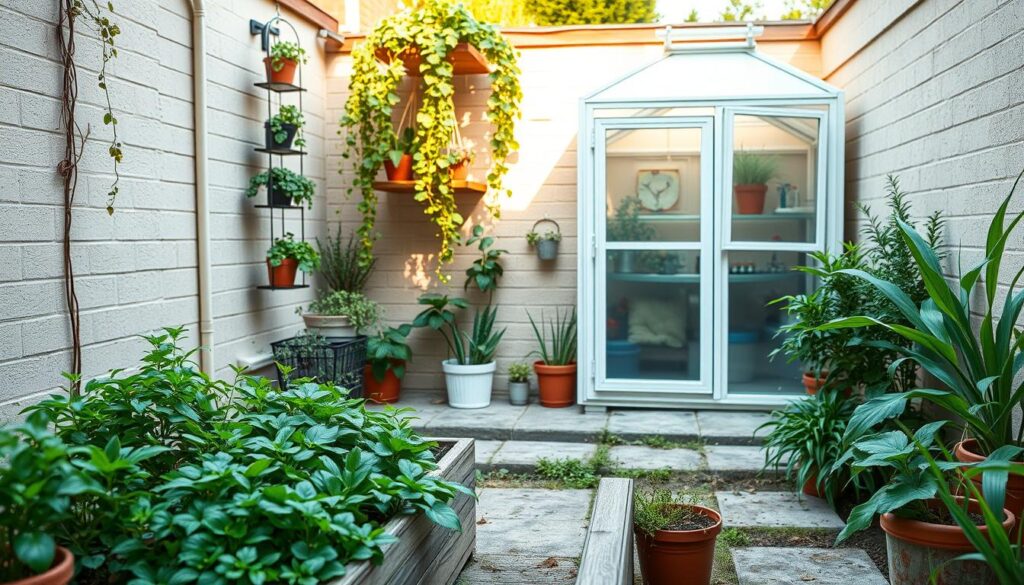
Maximizing Vertical Space
When floor space is limited, think upward. Vertical systems like Woolly Pocket walls or trellis panels can transform bare walls into lush greenery. These solutions are perfect for growing herbs, flowers, or even vegetables.
For example, ‘Patio Snacker’ cucumbers and ‘Tiny Tim’ tomatoes thrive in vertical setups. Pair them with solar-powered LED strips under railings for a functional and stylish look. Hanging strawberry towers are another great way to use air space effectively.
Choosing Compact Plants for Small Areas
Selecting the right plants is crucial for small spaces. Opt for compact plants like dwarf trees such as ‘Celestial’ fig or ‘Pink Cascade’ weeping peach. These varieties stay small but still produce fruit.
Self-watering pots with wicking systems are ideal for containers. They reduce maintenance and ensure your plants stay hydrated. For a touch of creativity, use diagonal paving or mirror accents to create optical illusions that make your space feel larger.
| Plant | Feature | Care Tip |
|---|---|---|
| ‘Patio Snacker’ Cucumber | Space-saving | Train on trellis |
| ‘Tiny Tim’ Tomato | Compact growth | Use self-watering pots |
| ‘Celestial’ Fig | Dwarf tree | Prune in late winter |
Finally, consider integrating storage solutions like bench seats with hidden compartments. This keeps tools and supplies out of sight while maximizing functionality. With these tips, you can turn any small space into a thriving and beautiful retreat.
8. Eco-Friendly Pollinator Gardens
Supporting local ecosystems has never been more important than now. Pollinators like bees and butterflies are essential for biodiversity and food production. By creating a space that welcomes these beneficial insects, you can make a positive impact on the environment while enjoying a vibrant and lively area.
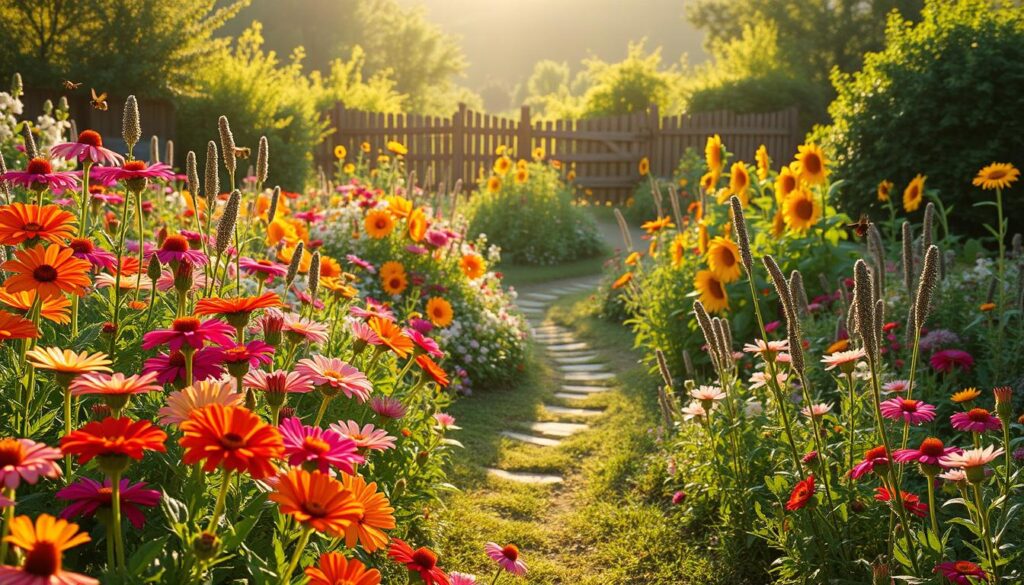
Attracting Bees and Butterflies
To attract pollinators, focus on providing food, water, and shelter. Include a mix of nectar-rich flowers like milkweed and purple coneflower. These native plants are not only beautiful but also support local wildlife.
Create nesting spots by leaving bare ground patches for solitary bees. Add a birdbath with pebble landing pads for water access. Moonflower vines can attract moths at night, adding another layer of biodiversity to your space.
Avoid harmful pesticides by using alternatives like neem oil or diatomaceous earth. These options protect beneficial insects while keeping pests at bay.
Selecting Native Plants for Sustainability
Choosing native plants is key to a sustainable setup. Species like beardtongue and goldenrod are well-adapted to local conditions and require less maintenance. They also provide continuous blooms from early spring to late fall.
Host plants like parsley and pawpaw trees are essential for specific pollinators. For example, parsley supports swallowtails, while pawpaw trees are vital for zebra swallowtails.
| Plant | Pollinator | Benefit |
|---|---|---|
| Milkweed | Monarch Butterflies | Essential for reproduction |
| Purple Coneflower | Bees | Rich in nectar |
| Beardtongue | Hummingbirds | Long blooming period |
Consider joining initiatives like the Xerces Society’s “Bring Back the Pollinators” campaign. These programs offer resources and certification opportunities, such as the NWF’s Certified Wildlife Habitat requirements.
By adopting these practices, you can create a thriving pollinator garden that supports local ecosystems and enhances your surroundings. Studies show that pollinator-friendly farms see a 45% increase in yields, proving the value of these efforts.
9. Zen Garden Inspiration for Tranquility
Finding peace in your outdoor space is easier than you think with a Zen-inspired setup. This style focuses on simplicity, balance, and mindfulness, creating a serene retreat that promotes relaxation and inner calm. Whether you have a large area or a small corner, these principles can transform your space into a sanctuary.
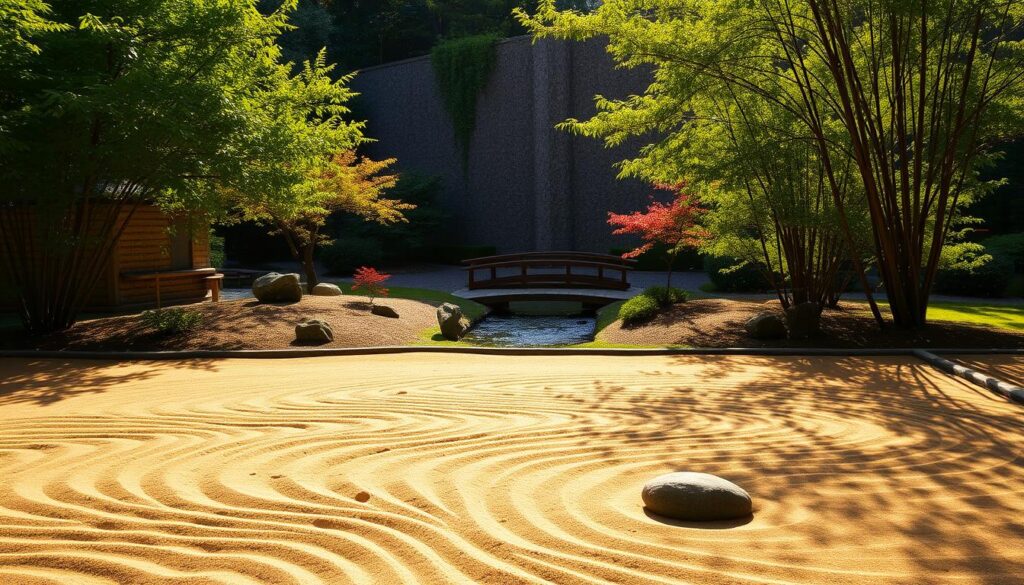
Incorporating Natural Elements
At the heart of a Zen-inspired space are natural elements like sand, stones, and moss. Sand symbolizes water, while stones represent mountains, creating a harmonious balance. Raking patterns in the sand can evoke different moods, from calm waves to flowing streams.
Add a bamboo shishi-odoshi water feature for a soothing soundscape. Plants like Japanese maple ‘Bloodgood’ and dwarf mondo grass enhance the natural feel. These elements work together to create a space that feels both grounded and serene.
Designing for Relaxation and Meditation
When planning your space, focus on simplicity and functionality. A teak platform with zabuton cushions provides a comfortable spot for meditation. Use charred wood shou sugi ban fencing for a rustic yet modern boundary.
Lighting plays a key role in setting the mood. Warm LED paper lanterns create a soft glow, perfect for evening relaxation. Daily raking of the sand can become a mindful practice, helping you stay present and centered.
- Essential elements: Sand, stones, moss
- Raking patterns: 7 traditional styles
- Soundscape: Bamboo shishi-odoshi
- Plants: Japanese maple, dwarf mondo grass
- Seating: Teak platform with cushions
- Boundary: Charred wood fencing
- Lighting: Warm LED lanterns
- Maintenance: Daily raking as mindfulness
- Symbolism: Odd-numbered stone groupings
- Modern twist: Glass pebble “streams”
10. Edible Landscaping: Combining Beauty and Function
Transform your space into a blend of beauty and practicality with edible landscaping. This approach allows you to grow fruits and vegetables while maintaining an attractive and organized layout. It’s a smart way to make your area both functional and visually appealing.
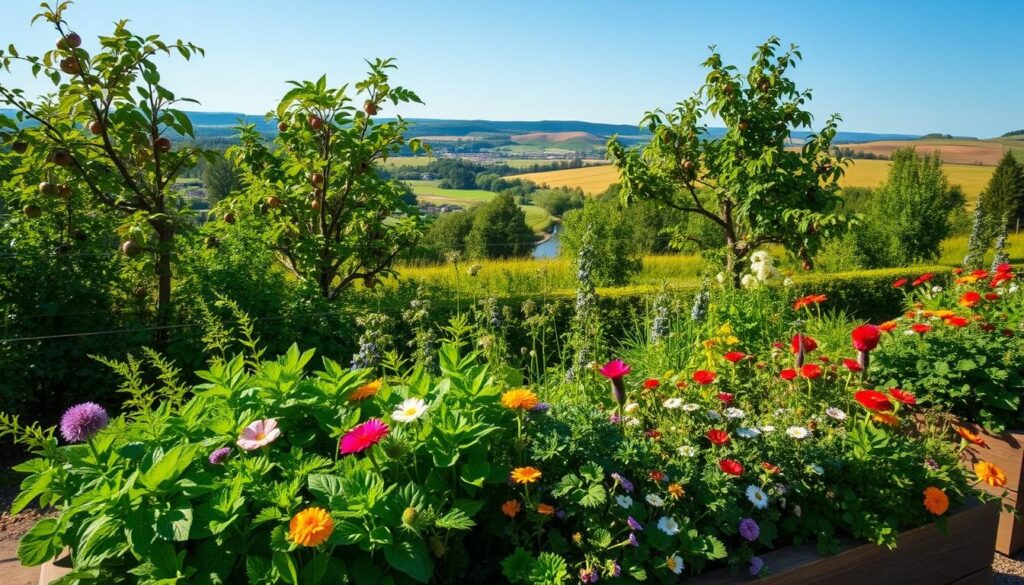
Integrating Fruits and Vegetables into Your Landscape
Start by selecting ornamental edibles like rainbow chard, purple kale, and alpine strawberries. These plants add vibrant colors and textures to your setup. For structure, consider espalier apple trees as living fences. They provide both shade and a harvest of fresh fruit.
Companion planting is another effective strategy. Pair marigolds with tomatoes to deter pests naturally. Nasturtiums work well with squash, adding a pop of color while repelling harmful insects. This method enhances biodiversity and keeps your space healthy.
Design Tips for a Productive and Beautiful Garden
Plan for year-round productivity with a succession planting schedule. This ensures a continuous harvest throughout the seasons. Use row covers disguised as decorative cloches to protect your crops from pests and harsh weather.
Vertical layers can maximize space and add depth. Plant blueberry bushes under pear trees for a multi-level setup. Aesthetic pruning, like shaping rosemary or bay into topiaries, adds a touch of elegance to your edible landscape.
| Plant | Feature | Care Tip |
|---|---|---|
| Rainbow Chard | Colorful leaves | Harvest outer leaves first |
| Espalier Apple Trees | Space-saving | Prune in late winter |
| Marigolds | Pest deterrent | Plant near tomatoes |
Finally, consider your USDA hardiness zone when selecting plants. This ensures they thrive in your region. With these tips, you can create a productive and beautiful space that’s both functional and stunning.
11. Seasonal Garden Transformations
Adapting your space to the changing seasons ensures year-round beauty and functionality. Whether it’s protecting your area from harsh winter conditions or refreshing it for spring and summer, a thoughtful approach keeps your outdoor retreat vibrant and healthy.
Preparing Your Space for Winter
As temperatures drop, it’s essential to safeguard your area. Start by mulching around perennials to insulate roots. Wrap young trees with burlap to protect them from frost damage. Prune dead branches to prevent breakage under snow.
For winter interest, add plants like red osier dogwood and winterberry holly. These provide color and texture even in colder months. Leave seed heads standing until March to support wildlife.
Here’s a quick checklist for winter prep:
- Mulch perennials and shrubs.
- Wrap young trees with burlap.
- Prune dead or weak branches.
- Add winter-interest plants.
- Leave seed heads for wildlife.
Spring and Summer Refresh Ideas
When spring arrives, it’s time to wake up your space. Begin with soil solarization to control pests naturally. Use a laser-etched planting map template to organize spring bulbs like tulips and daffodils.
For summer, install shade cloth to protect delicate plants from intense heat. Use movable containers for tropicals like hibiscus and mandevilla. These add vibrant color and can be repositioned as needed.
Consider these tips for a seasonal refresh:
| Season | Task | Benefit |
|---|---|---|
| Spring | Soil solarization | Pest control |
| Spring | Plant bulbs | Early blooms |
| Summer | Install shade cloth | Heat protection |
| Summer | Use movable containers | Flexible design |
Finally, maintain your tools by sharpening them regularly. A well-maintained toolset ensures efficiency and longevity. By following these steps, you can enjoy a thriving space throughout the year.
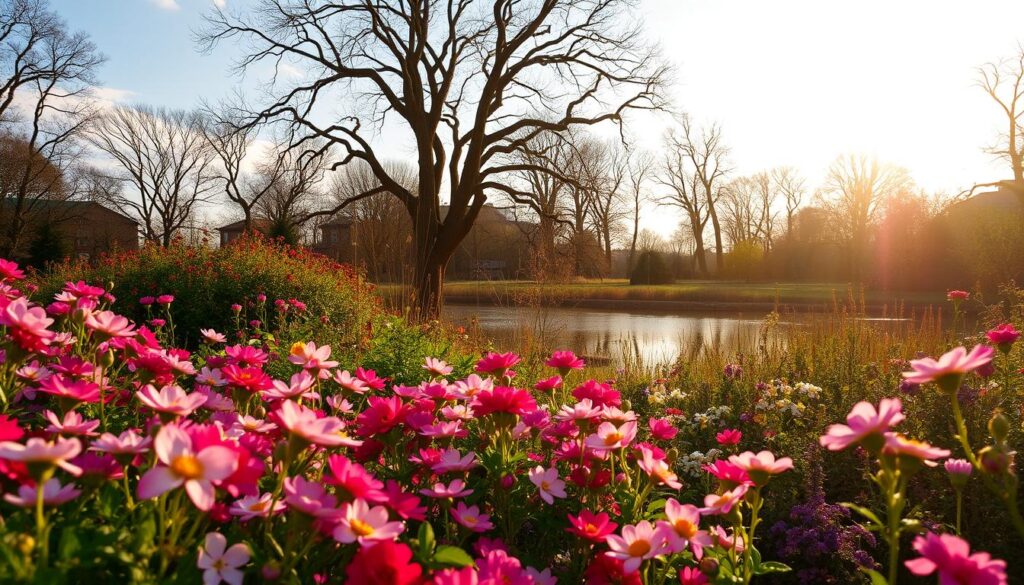
Conclusion: Your Perfect Garden Awaits
Your journey to a beautiful and functional outdoor retreat starts with small, intentional steps. Whether you begin with a single raised bed or a container setup, the key is to take action. Downloadable plans from trusted sources can guide you through the process, making it easier to achieve your vision.
The long-term benefits are worth the effort. Studies show that spending time in your outdoor space can reduce stress by 23%. Plus, it can boost your property value significantly. Share your progress with the hashtag #TransformedYard to inspire others.
Looking ahead, trends like smart soil sensors and mycorrhizal inoculants are shaping the future of outdoor spaces. Resources like the Almanac Planner and NWF certification can help you stay ahead. As the saying goes, “The best outdoor space is the one that brings you joy daily.”
Maintenance doesn’t have to be overwhelming. A daily 10-minute routine is more effective than weekend marathons. Use a seasonal checklist to stay on track for the next 90 days. Your perfect retreat is within reach—start today!

